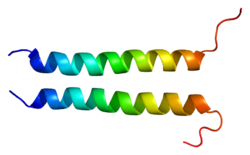T-cell surface glycoprotein CD3 zeta chain also known as T-cell receptor T3 zeta chain or CD247 (Cluster of Differentiation 247) is a protein that in humans is encoded by the CD247 gene. [5]
Some older literature mention a similar protein called "CD3 eta" in mice. It is now understood to be an isoform differing in the last exon. [6]






